 Image search results - "kinomoto" Image search results - "kinomoto" |
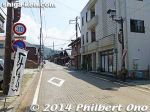
Kinomoto is a former post town along the old Hokkoku Kaido Road going to the Hokuriku region. This is Jizo-zaka slope leading to the Kinomoto Jizo-in temple. 地蔵坂
|
|
|

Building on Jizo-zaka which was later torn down.
|
|
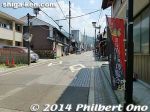
Jizo-zaka slope
|
|
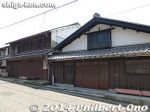
Jizo-zaka has a few traditional buildings.
|
|
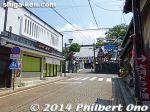
At the top of Jizo-zaka.
|
|
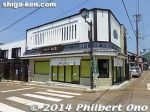
Well-known confection shop on Jizo-zaka.
|
|
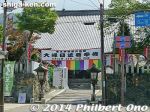
Kinomoto Jizo-in temple at the end of Jizo-zaka road.
|
|

Near Kinomoto Station is Jizo-zaka road, a slightly sloping cobblestone road leading to the Jizo-in temple. During the annual Kinomoto Jizo Ennichi Festival held on Aug. 22-25, this road is packed with food stalls and people going to worship. 地蔵縁日
|
|

Jizo-zaka road. Ennichi is the temple or shrine's auspicious or special commemoration days. When you go to worship on such days, your prayers will be answered in better ways than usual. The festival is held from 9 am to 10 pm. 地蔵坂
|
|

Jizo-zaka as seen from Jizo-in temple. On the last day of the festival (Aug. 25)., fireworks is held from 8 pm to 8:30 pm.
|
|

Jizo-zaka road as seen from the temple.
|
|

Kinomoto Jizo-in temple during the Kinomoto Jizo Festival held Aug. 22-25. MAP
|
|

What Jizo-zaka looks like from the Jizo-in temple entrance.
|
|

Going to worship at Kinomoto Jizo-in temple.
|
|

During the annual Kinomoto Jizo Festival, an endless stream of people come to worship.
|
|

Lighting incense.
|
|

Worshippers inside the Kinomoto Jizo-in temple. Scroll down further to see what it looks like without all the people.
|
|

View from the temple.
|
|

Giant Jizo statue overlooks food stalls within the temple grounds.
|
|

Kids catching small colorful balls in the water with a paper net.
|
|

You can exchange the balls with prizes (more balls = better prizes).
|
|

Votive prayer tablets with frog design.
|
|

Jizo statue
|
|

On Hokkoku Kaido Road fronting the temple, more food/game stalls.
|
|

Hokkoku Kaido Road
|
|

Hokkoku Kaido Road
|
|

Former bank building called Koyukan, now used for flea markets and other events. 交遊館
|
|
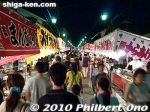
Ennichi in the evening as people stick around for the fireworks.
|
|
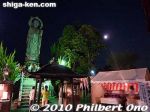
Kinomoto Jizo-in temple in the evening of ennichi festival.
|
|

Jizo-in entrance along the Hokkoku Kaido road. This is how it looks on normal days. These photos were taken in Jan.
|
|

Entrance to Jizo-in or Joshinji temple. This is how the temple looks on less crowded days. 木之本地蔵院
|
|

Kinomoto Jizo-in Hondo temple hall on the left and giant Jizo statue on the right. 木之本地蔵院
|
|

Hondo 本堂 地蔵堂
|
|

Stone lantern, giant Jizo, and temple bell
|
|

Hondo 地蔵堂
|
|

Flags and temple roof.
|
|

Frog fountain
|
|

Kawara roof tile donations. 奉納瓦
|
|

Kawara roof tile donations, 2000 yen per tile. You get to write on it too. 奉納瓦
|
|
|
|

Omikuji fortune paper tied to strings.
|
|

Temple bell
|
|

Jizo statue and temple bell
|
|

Giant Jizo statue and incense burner, Kinomoto Jizo-in, Shiga 木之本地蔵院
|
|

Giant Jizo statue stands 6 meters tall.
|
|

Built in 1894 (Meiji 27), the Jizo statue is Japan's largest Jizo statue. 地蔵大銅像
|
|

Giant Jizo statue. (Cannot go inside the statue.) 地蔵大銅像
|
|

This statue is a large replica of the actual Jizo statue worshipped in the temple. 地蔵大銅像
|
|

Base of giant Jizo statue
|
|

Base of giant Jizo statue covered with frogs which help people receive divine blessings from the Jizo. 身代わり蛙
|
|

Base of giant Jizo statue and frogs. Buy a frog for 1,000 yen and write your name and age on it and place it here. 身代わり蛙
|
|

One eye is closed. For people with eye or vision/health problems, the frogs are trying to take their place and bear the problem while the Jizo is to give blessings to the person. 身代わり蛙
|
|

Up view
|
|

Profile view
|
|

Back view of Jizo statue
|
|

Hondo steps
|
|
|

Inside temple hondo main hall
|
|

Altar straight ahead.
|
|

Red rope for ringing a bell.
|
|

Ema votive tablets with Year of the Boar
|
|

Side of Hondo main hall and entrance to the basement corridor. 御戒壇巡り
|
|

Basement corridor of Hondo. Totally dark. Admission 300 yen. 御戒壇巡り
|
|

Basement corridor of Hondo. 御戒壇巡り
|
|

Stone monument
|
|

Small Jizo statues out front
|
|

Small Jizo statues
|
|

Small Jizo statues
|
|

Entrance to Amida-do temple which is next to the Jizo temple 阿弥陀堂
|
|

阿弥陀堂
|
|

Amida-do hall 阿弥陀堂
|
|

Altar in Amida-do hall, Jizo-in, Kinomoto, Shiga 阿弥陀堂
|
|

Inside Amida-do altar
|
|
|

Inside Amida-do hall
|
|

Torii
|
|

Shrine
|
|

Shoin 書院
|
|

Shoin entrance and where Emperor Meiji rested. 書院
|
|

Inside shoin 書院
|
|

書院
|
|

Shoin altar
|
|

Shoin and garden
|
|

Famous Japanese garden outside the shoin 文部省指定の名勝庭園
|
|

Famous garden outside the shoin 文部省指定の名勝庭園
|
|

Shoin
|
|

Emperor Meiji's room in the shoin when he visited Kinomoto.
|
|

Emperor Meiji's room. Notice the elevated tatami mat and footwear.
|
|

Palanquins in the shoin
|
|

Corridor to the back of the Hondo main hall. 地蔵尊縁起絵
|
|

Jizo paintings 地蔵尊縁起絵
|
|

Perfumed water?
|
|

Ura-Jizo (Rear Jizo) at the back of the Hondo, now open to the public from Jan. 2007. 裏地蔵尊
|
|

Temple walls as seen from the Hokkoku Kaido road.
|
|

Hokkoku Kaido road going through post town Kinomoto-juku 北国街道
|
|
|
|

Area where horses were sold and where Lord Yamauchi Kazutoyo's wife Chiyo bought a fine horse. The home on the left has an Udatsu slat (white) うだつ
|
|

Former horse seller.
|
|
|

Horse market 木之本牛馬市跡
|
|

Photo op for tourists, where Kazutoyo bought his famous horse.
|
|
|

Area where horses were sold.
|
|

Site of horse sale.
|
|

Hokkoku Kaido banner
|
|
|

Old-style mailbox and road marker.
|
|

Looks very traditional except for the car.
|
|

Site of Kinomoto-juku's Honjin. 本陣跡
|
|

Site of Kinomoto-juku's Honjin along the Hokkoku Kaido road south of Jizo-in. 本陣跡
|
|
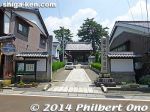
Temple visited by Rennyo in the 15th century. 明楽寺
|
|

Myorakuji Temple in Kinomoto. 明楽寺
|
|

Myorakuji Temple in Kinomoto. 明楽寺
|
|

Stone on which Rennyo sat in the 15th century. It felt comfortable enough.
|
|

Myorakuji Temple in Kinomoto being renovated in 2007. Designated as National Tangible Cultural Property in spring 2023. 明楽寺 国の登録有形文化財
|
|

明楽寺
|
|
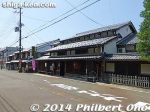
Traditional townscape in Kinomoto
|
|
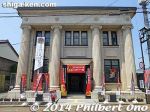
Former bank building called Sengoku Taiga Kinomoto-kan (戦国大河きのもと館). Has served as a venue for local expos.
|
|

Ohofura Jinja Shrine
|
|

Ohofura Jinja Shrine torii
|
|

Way to Shakudoji temple
|
|

Shakudoji temple marker. MAP
|
|

Front of Shakudoji temple
|
|

About Shakudoji temple
|
|

Steps to Shakudoji temple
|
|
|

Side view of Shakudoji temple
|
|
|
|

Pond in front of Shakudoji
|
|

There are a few walking paths next to Shakudoji. I walked on a path to see where it would take me.
|
|

To Keisokuji temple, noted for fall leaves.
|
|
|
|
|
|
|
|
|
|
|
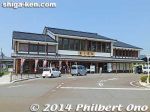
JR Kinomoto Station on the Hokuriku Line opened in Oct. 2006. 木之本駅
|
|

The front plaza was still under construction in Jan. 2007.
|
|

Bicycle garage and new Kinomoto Station.
|
|

Front of station still under construction.
|
|
|

First floor of station with tourist info counter and souvenir shop.
|
|

2nd floor of station with ticket machine and turnstile.
|
|

Corridor
|
|

Men's restroom made of wood. Very nice.
|
|
|
|

Kinomoto Station as seen from the train.
|
|

Kinomoto Station as seen from the train.
|
|

Train tracks
|
|
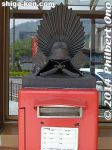
Mail box with a samurai helmet sculpture on it. In reference to the Battle of Shizugatake.
|
|

Old Kinomoto Station platform
|
|

Old Kinomoto Station
|
|

Old Kinomoto Station which was used from 1936 to 2006. 旧木之本駅
|
|

Old Kinomoto Station now has a new paint job.
|
|

Old Kinomoto Station looking new.
|
|

Old Kinomoto Station entrance and sign
|
|

Inside old Kinomoto Station, apparently used as an occasional exhibition space.
|
|
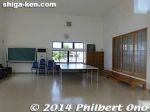
Inside Old Kinomoto Station. Apparently used occasionally.
|
|

Old Kinomoto Station
|
|

In front of the old Kinomoto Station.
|
|
|

Kinomoto manhole, Shiga Pref.
|
|

From the train approaching JR Kinomoto Station on the Hokuriku Line, you can see the chair lift trail on the slope of Mt. Shizugatake. To reach Shizugatake from Kinomoto Station, take a bus bound for Sugaura (菅浦) or Shindono (新道野).
|
|

Get off at the Ooto (大音) bus stop as seen here, and cross the road and walk toward the mountain.
|
|

Sign pointing the way to Shizugatake. MAP
|
|

You can see white banners on the top of Shizugatake.
|
|

From the parking lot, there is a short path to the chair lift.
|
|

Mt. Shizugatake chair lift costs ¥450 one way, or ¥900 round trip (as of Jun 2021). If you plan to hike down to Lake Yogo (recommended), buy a one-way ticket.
|
|

Chair lift going to Mt. Shizugatake. This lift operates April-Nov., 9 am - 5 pm. Closed during winter.
|
|

At the top of the chair lift. Mt. Shizugatake chair lift (500 meters long) started operating in Aug. 1959. It takes 6 minutes to go up to the top.
|
|

After you get off the chair lift, walk up the slope for 300 meters to the summit.
|
|

A small shrine along the way.
|
|

A small shrine dedicated to the warriors who died at battle on the mountain.
|
|
|
|
|

Near the summit are the white banners we saw from the foot of the mountain. They are written with the names of Hideyoshi's so-called "Seven Spears," in reference to his top seven samurai generals who went to battle at Shizugatake.
|
|

The seven generals were Fukushima Masanori (1561-1624), Hirano Nagayasu (1559-1628), Kasuya Takenori (1562-1607), Katagiri Katsumoto (1556-1615), Katō Kiyomasa (1562-1611), Katō Yoshiaki (1563-1631), and Wakizaka Yasuharu (1554-1626).
|
|
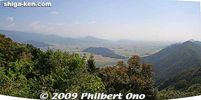
On this side of Shizugatake is a great view looking south.
|
|

Lookout deck for the south.
|
|

View looking south.
|
|
|

Marker for the Battle of Shizugatake and the famous "Seven Spears" which refer to Hideyoshi's top generals in the battle.
|
|

On the other side of Shizugatake is this lookout deck.
|
|

Great views of northern Lake Biwa as seen from Mt. Shizugatake.
|
|

Northern Lake Biwa, looking toward Sugaura. Seen from Mt. Shizugatake.
|
|
|
|

That's Chikubushima island on the left.
|
|
|
|
|
|
|
|

Shimmering waters of Lake Biwa.
|
|

Yogo mountains
|
|

In the lookout deck is this board to hang votive tablets on which people write their wishes.
|
|

Older votive tablets which were removed from the wall are preserved as photos in this photo album.
|
|

Another worn out monument on Shizugatake.
|
|
|
|
|

Summit of Shizugatake. A small flat clearing.
|
|
|

Samurai statue on Mt. Shizugatake
|
|
|
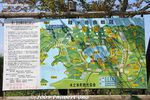
Map of Shizugatake and Yogo area.
|
|

About the Battle of Shizugatake.
|
|
|
|

Lookout deck for Lake Yogo.
|
|
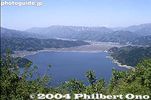
Lake Yogo as seen from Mt. Shizugatake in Nagahama, Shiga. This is in May.
|
|

Lake Yogo as seen from Mt. Shizugatake. This is in Sept. Looks greenish due to algae perhaps. Been like that since Aug. It turns blue again in fall.
|
|
|
|
|
|
|
|
|

At one end of the summit area is a hiking trail leading to the far end of Lake Yogo, toward Yogo Station. The trail is 3.9 km.
|
|

The trail is heavily wooded, and sometimes there is a clear area where you can see the scenery.
|
|

Hiking trail to Lake Yogo.
|
|

View of Nagahama.
|
|
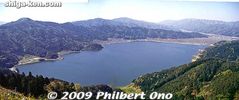
Lake Yogo as seen from the hiking trail on Mt. Shizugatake in Nagahama, Shiga Prefecture.
|
|
|

Lake Yogo gets closer toward the end of the trail.
|
|
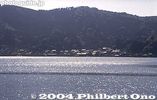
Lake Yogo
|
|

Another trail from the summit of Shizugatake is next to this lookout deck.
|
|

This trail is the shortest route to Lake Yogo. It goes down to the Yogo-so minshuku.
|
|

Dense forest, somewhat rocky at times. Go right here.
|
|
|
|

At the end of this trail is this shore of Lake Yogo, on the opposite end from Yogo Station. You still have to walk along one side of the lake to get to the train station. It's a scenic walk.
|
|

The defunct Yogoko-so Kokuminshuku lodge at the southern tip of the lake. It had a scenic view of the lake. This was a national pension with affordable prices. 国民宿舎 余呉湖荘Sadly, after 40 years in business, this pension closed in Sept. 2013 due to aging facilities that were too expensive to repair. It has been torn down.
|
|
|
|
|